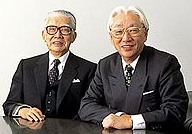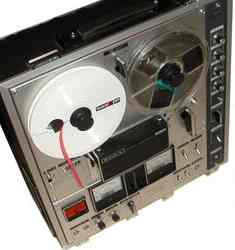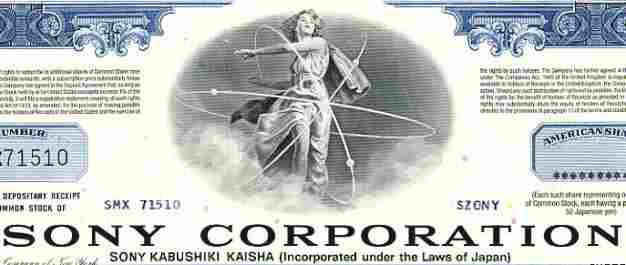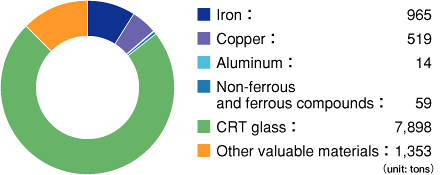|
SONY CORPORATION
|
||||||||||||||
|
HOME | BIOLOGY | FILMS | GEOGRAPHY | HISTORY | INDEX | INVESTORS | MUSIC | NEWS | SOLAR BOATS | SPORT |
||||||||||||||
|
Sony Corporation is a tremendous Japanese success story producing consumer electronics and associated services. The company was incorporated on 7 May 1946 as Tokyo Telecommunications Engineering Corporation. Its founders were Ibuka Masaru, whose Japan Precision Instruments Company had supplied electronic devices during World War II, and Morita Akio, an applied sciences instructor.
Mr Ibuka and Mr Morita 1996 - Sony 50th anniversary
A 1969 Sony TC-630 reel-to-reel recorder
Sony Corporation (Japanese katakana: ソニー)
(NYSE:SNE (http://www.nyse.com/about/listed/lcddata.html?ticker=SNE)) is a consumer electronics corporation based in Tokyo, Japan. It was founded by Masaru Ibuka and Akio Morita on May 7, 1946 as the Tokyo Telecommunications Engineering with about 20 employees. Their first consumer product, in the late 1940s, was a rice boiler. As it grew into a major international corporation, Sony acquired other companies with longer histories, including Columbia Records (the oldest continuously produced brand name in recorded sound, dating back to 1888). Today Norio Ohga is Honorary Chairman, Nobuyuki Idei is Chairman and CEO, and Kunitake Ando is president of the corporation.
When Tokyo Tsushin Kogyo was looking for a romanized name to use to market themselves, they strongly considered using their initials, TTK. The primary reason they did not, is that the railway company Tokyo Kyuko was known as TKK.
The name "Sony" was chosen for the brand as a mix of the Latin word sonus, which is the root of sonic and sound, and the English word "sunny." At the time of the change, it was extremely odd for a Japanese company to use Roman letters to spell its name, much less the phonetic script used in the Japanese writing, instead of Chinese characters.
The move was not without opposition; TTK's principal bank at the time, Mitsui, had strong feelings about the name. They pushed for a name such as Sony Electronic Industries, or Sony Teletech. Akio Morita was firm, however, as he did not want the company name tied to any particular industry. Eventually, both Ibuka and Mitsui Bank's chairman gave their approval. In 1988, Sony acquired CBS (Columbia) Records Group from CBS. It was renamed "Sony Music Entertainment".
In 2000, Sony had sales of US $63 billion and 189,700 employees. Sony acquired Aiwa corporation in 2002. Sony also owns television channels in India and channels aimed at Indian communities in Europe.
Sony has historically been notable for pushing its own in-house standards for new recording and storage technologies, which are often different from those of other manufacturers or of market trends and standards. The most infamous of these was the videotape format war of the early 1980s, when Sony marketed its Betamax system for video cassette recorders against the VHS format developed by JVC. In the end, VHS gained critical mass in the marketplace and became the worldwide standard for consumer VCRs and Sony had no choice but to capitulate.
Sony has continued the same tactic with subsequent technologies; for example, it pushes its MiniDisc digital recording format (intended to replace cassette tapes) whilst rivals favour CD-R and MP3 instead. Sony also makes heavy use of its Memory Stick flash memory modules for digital cameras and other portable devices, which few other manufacturers use. It also attempted to compete with the Iomega Zip drive and Imation Superdisk with their HiFD, but this proved a severe failure.
Since the introduction of the MiniDisc format, Sony has attempted to promote its proprietary audio compression technologies under the ATRAC brand, against more widely-used formats like MP3 and Windows Media Audio. Until late 2004, Sony's various digital portable music players did not support even the de facto standard MP3 natively, although the software provided with them would convert MP3 files into the ATRAC formats.
In 2004, the London Borough of Camden, England brought Anti Social Behaviour Orders (ASBOs) against Sony Music UK and BMG for alleged fly posting. Illegal fly posting by the two companies is thought to save them £8 million a year in advertising costs in Camden and cost the Borough £250,000 to clean up. Failing to comply with an ASBO can result in a jail sentence of up to 5 years.
On July 20th, 2004, the EU approved a 50-50 merger between Sony Music Entertainment and BMG. The new company will be called Sony BMG and will, together with RIAA partner Universal, control 60% of the world wide music market.
On September 13th 2004 a Sony-led consortium finalised the deal to purchase famous film studio Metro-Goldwyn-Mayer for about $5 Billion, including $2Bn in debts. Shareholders (as of march 2004)
Sony Corporation is traded on the Tokyo Stock Exchange under number 6758 and on the NYSE as SNE through ADR. Holdings
Film production
Music business
Video and online games
Notable products and technologies
LINKS and REFERENCE
RECYCLING ACTIVITIES IN JAPAN
The
Home Appliance Recycling Law that came into effect in Japan in April
2001 covers four major types of home appliances: televisions,
refrigerators, washing machines and air conditioners. Of these, the
only product that Sony manufactures is televisions (defined as
containing a CRT, and including Aiwa brand models). A total of
approximately 490,000 Sony-manufactured televisions were recycled in
fiscal 2003.
TELEVISION RECYCLING
Sony has been developing recycling technology primarily for large televisions since fiscal 1991. In October 1997, we established the Recycling Research Center to reinforce this development. Some plants that recycle Sony-manufactured televisions employ disassembly machines and other technologies developed by this Research Center. The Research Center conducts research on actual recycling conditions, and provides feedback to television designers and engineers so that new products can be made more easily recyclable.
POLYSTYRENE FOAM PACKING RECYCLING
Since January 1999, Sony has been recycling the waste polystyrene foam generated by the Group companies with a recycling system using limonene, a substance derived from orange peel. In fiscal 2003, approximately 99 tons of this foam was collected and recycled into new polystyrene foam for use as packing material for nearly 360,000 large-size and LCD projection televisions.
RECYCLING PERSONAL COMPUTERS
From
October 2003 in Japan, the Law for the Promotion of Effective
Utilization of Resources has required the recycling of computers used
by private citizens, in addition to the recycling of personal
computers discarded by corporate users which was already underway.
Resources
Recycled from Televisions
HISTORY OF THE COMPANY:
Tastes for adventure capitalists
Solar Cola | Solar Citrus | Solar Crush | Solar Energy - healthier alternatives
|
||||||||||||||
|
This
website
is Copyright © 1999 & 2007 NJK. The bird |
||||||||||||||
|
AUTOMOTIVE | BLUEBIRD | ELECTRIC CARS | ELECTRIC CYCLES | SOLAR CARS |




